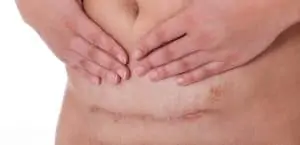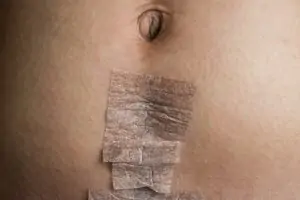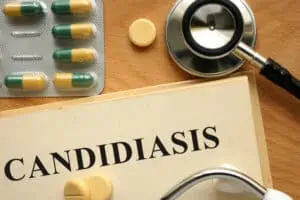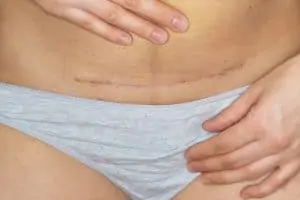Healing after your c-section can be a bit tricky at times, and some women experience recurrent yeast infections. No matter if you have a skin or vaginal yeast infection, they aren’t fun and can be difficult to stop.
You aren’t alone.
Women face this problem all of the time, and it happens in all different types of surgeries. It’s not embarrassing, and with the right treatment and preventative measures, you can stop yeast infections from returning multiple times.
Here is what you need to know.
Why Do You Get Yeast Infections After a C-Section
Yeast is caused by a fungus called Candida, which is often found throughout your GI tract. Candida thrives in warm, moist environments, such as surgical sites, diaper regions, and vaginas, but it’s not just limited to those regions.
After surgery, you have some conditions that increase the risk of developing one because you might have moist skin under the wound dressing. Your clothing might be too tight or create too much humidity around your wound.
If you have a fold of skin that lays over your incision, it might cause constant moisture contact, leading to the overgrowth of the fungus.
Are Vaginal Yeast Infections Common After a C-Section?
Unfortunately, yes, vaginal yeast infections can become more common after your surgery. When you have your surgery, you will receive 2-3 bags of fluid antibiotics to prevent the development of an infection in your uterus or incision.
Caution:
If you’ve ever taken antibiotics before, you know that the use of antibiotics can increase the risk of a vaginal yeast infection. Antibiotics kill off bacteria, which leads to an overgrowth of yeast inside your body. It also means your baby might end up with thrush after birth.
It can be very uncomfortable to have a yeast infection while recovering from birth. Be sure to let your doctor know so you can receive the right medication.
The Signs
How do you know if you have a yeast infection? You have to watch out for signs, and there are different signs of vaginal yeast infections and infections on your incision.
Signs of a Yeast Infection on Your Incision
Identifying the symptoms of an infection on your incision or around your incision can be a bit harder. The area already tends to be red and warm from the healing process. Here are some of the signs you might notice.
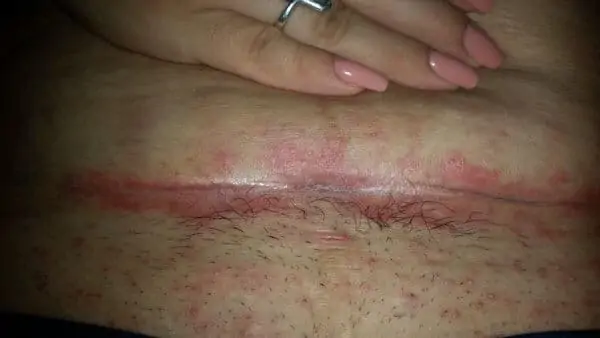
- Red, scaly, or bumpy skin
- Beefy redness
- Itching, dry skin
- A slight odor coming from the incision
- Skin lesions
- Swelling
- Any other changes in the skin color
Try looking at pictures of a yeast infection on the skin to get a better idea if this is what you have.
Signs of a Vaginal Yeast Infection
Here are the most common symptoms.
- Itching and irritation
- A burning feeling
- Redness
- Swelling
- Pain or soreness
- Watery vaginal discharge
- Different vaginal discharge that might be thicker, white, or even yellow
How to Prevent a Yeast Infection after a C-Section
In most cases, it’s easier to prevent a yeast infection rather than try to combat an active infection. Here are some tips that you can use to reduce moisture after your incision.
Use Absorptive Fabric
If you have a fold of skin that goes over your incision, try putting pieces of gauze in between the fold of the skin. Doing so lets the moisture soak into the bandage, which keeps the region dry. You need to have plenty of dressing on hand and change it often.
Once it becomes damp, it needs to be changed out for a dry piece of dug.
Let Dry After a Shower
You need to focus on drying the skin well after your showers. Take your towel, pat it dry, and let the area air dry. You can also use a hairdryer on the cool setting to ensure your skin is really dry.
Change Underwear Often
Any moisture is problematic, and if the gauze you have in the area becomes damp, you should consider changing your underwear if it is moist too. Dryness is the key to success.
Reduce Friction
You also need to decrease friction, so make sure none of the clothes you wear is too tight. Avoid elastic on the area that might rub and irritate the incision even more.
Treating a Yeast Infection
In most cases, your doctor will prescribe you an over-the-county medication to help get rid of the yeast infection. He might also prescribe an antifungal powder to help keep the area dry.
That doesn’t mean you can’t try some natural remedies as well. You need to be careful not to irritate your skin further, but here are some suggestions to get an overgrowth of yeast out of your system.
- Try an OTC Spray
If your doctor doesn’t give you a powder spray, you can buy one at the store. Lotrimin has a powdery spray that you can add over your incision that makes it not so weepy, letting it heal easier. You can apply the spray three times per day.
- Take Probiotics
Taking probiotics can put healthy bacteria back into your GI tract, which will combat the overgrowth of Candida in your system.
- Eat Lots of Yogurts
Eating yogurt and other fermented foods, such as kombucha, introduce good bacteria to your diet. If you have a scheduled c-section, you should start to increase your consumption of these foods 2-3 weeks before your surgery. Then, continue to eat them for 2-3 weeks afterward for optimal results.
- Change Your Pad Often
Even though you had a c-section, you still will bleed vaginally, and keeping the same pad on for too long creates too much moisture in and around your vagina. You must ensure that the area is as dry and clean as possible.
The same goes for any pad or gauze that you have on your incision. I often kept a maxi pad on my underwear so it covered my incision and stopped my underwear from rubbing. That pad needs to be changed regularly.
- Take Good Care of Your Incision
You have a few goals if the yeast infection is on or around your incision. Here they are.
- Make sure you take a shower (read when you can take a bath) daily and let the soap run over your incision. Don’t scrub it; just let it run over the area.
- Make sure it stays as dry as possible.
- Apply your OTC cream as often as indicated in the instructions.
- Use an antifungal powder to keep the area dry as well.
- Try to let it have air exposure as often as possible.
- Avoid tight-fighting clothes.
- Take More Vitamin C
Vitamin C is a great way to boost your immune system and fight back the Candida overgrowth. Your prenatal vitamin (which you still need to take after birth) should have vitamin C, but you also can take an extra supplement.
Consider adding some foods that are high in vitamin C to your diets, such as citrus fruits and broccoli.
Here is a comprehensive guide on your meal plan after cesarean delivery.
Don’t Put Anything in Your Vagina
Many natural remedies encourage you to put things into your vagina, such as boric acid or garlic. While these natural remedies work, they increase the risk of a vaginal or uterus infection. Nothing should enter your vagina until your doctor indicates it’s safe.
Final Thoughts
A yeast infection is annoying and often frustrating to get rid of entirely. However, it’s not a reason to panic, and it’s a prevalent issue seen by doctors. So, call your doctor and ask for some medicine to take care of it before it gets more annoying.
Hey, this is Linda. My biggest accomplishment in life is being a mother of four children. Their current ages range from almost ten years old down to 20 months old.
I’m passionate about writing parenting articles because I understand so well all of the problems and trials you face as a parent. From breastfeeding woes to budgeting problems and behavior problems, along with everything in between, chances are I’ve faced it over the last ten years. Read more about Linda here.

